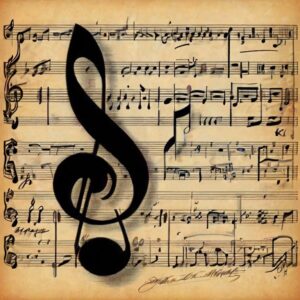Transcription in classical music involves taking a composition originally intended for one instrument or ensemble and adapting it for another. It is an art form that holds a unique place in the world of music, combining the skills of arrangement, interpretation, and sometimes, improvisation. This artistic endeavor has been a critical aspect of musical development, allowing compositions to be experienced in new contexts and by broader audiences.
The Origins and Evolution of Musical Transcription
The practice of transcribing music dates back hundreds of years. During the Baroque period, composers like Johann Sebastian Bach were renowned for transcribing their own works and those of others. Bach’s transcriptions of Vivaldi’s concertos into organ and harpsichord works are among the most celebrated. These adaptations were not about shifting music from one instrument to another; they were about reimagining the works entirely, bringing out new textures and harmonies that complimented the new medium.
In the classical and romantic eras, musicians continued this tradition. Composers like Franz Liszt and Sergei Rachmaninoff, both virtuoso pianists, transcribed symphonies and operas for solo piano. These were not just simplifications of the originals; they were complex reworkings that required virtuosic skill and deep interpretative insight.
The Role of Transcription in Expanding Musical Accessibility

Transcription facilitates wider dissemination and enjoyment of classical music, and enhances inclusivity by adapting compositions for performers with diverse abilities and for audiences that might otherwise not experience such works. For example, a piano transcription of a symphonic piece allows pianists to interpret and perform large-scale compositions independently, broadening the accessibility of these works to venues lacking orchestral resources, such as community centers, schools, and private homes. This adaptability furthers the reach of classical music, providing opportunities for more people to experience its depth and richness in various contexts.
Transcription is important in music education, serving as an essential tool for teaching and learning. By simplifying complex orchestral works into manageable pieces for individual instruments or smaller groups, transcriptions help students to gradually develop their musical skills and understanding. This educational strategy supports learners at different stages, enabling them to tackle sophisticated pieces at a pace suited to their ability levels. Transcription also encourages a comprehensive exploration of musical genres, styles, and periods, fostering a deeper appreciation and analytical insight among students and contributing to a more rounded and inclusive educational experience.
Technical Challenges and Creative Solutions
Transcribing a piece of music involves a variety of challenges. The transcriber must consider the limitations and strengths of the new instrument or ensemble. For instance, an orchestral work featuring a wide range of instruments, each with its own timbre and range, must be effectively condensed when adapted for solo piano. This requires an intimate knowledge of the piano’s capabilities and creative problem-solving to reproduce the textures and dynamics of the original score.
Adapting vocal music for instruments can be particularly challenging. The natural expressive quality of the human voice, with its ability to modulate tone and emotion, needs to be convincingly translated into instrumental terms. This often involves intricate adjustments to phrasing and dynamics to capture the vocal line’s expressiveness.
Artistic Insights Gained Through Transcription
Transcribing is not just a technical exercise; it is also profoundly interpretative. The transcriber must make numerous artistic decisions: What to emphasize, what to omit, and how to preserve the essence of the original while making the most of the new format. This process can lead to a deeper understanding of the original composition.
Engaging with a piece of music at such a detailed level exposes the transcriber to the compositional architecture and stylistic nuances that may not be apparent from surface-level engagement. Additionally, it provides performers and listeners alike with fresh insights into the work, often highlighting elements like thematic development, structural balance, and harmonic exploration in new and unexpected ways.
Celebrated Examples and Their Impact
Some of the most admired transcriptions have gained a place in the concert repertoire on their own merits. Franz Liszt’s piano transcriptions of Beethoven’s symphonies are a prime example. By translating these monumental orchestral works into the realm of solo piano, Liszt showcased his remarkable pianistic skills and brought out inner voices and counterpoints in Beethoven’s music that might be less perceptible in orchestral performances.
Another notable example is Maurice Ravel’s orchestration of Modest Mussorgsky’s “Pictures at an Exhibition.” Originally composed for piano, Ravel’s version elevates the piece through vivid orchestral coloring and texture, bringing a new dimension to Mussorgsky’s work. This version has become so popular that it frequently overshadows the original piano suite in the concert hall.
Current and Future Perspectives in Transcription
Transcription remains a dynamic field. With advances in technology and a more interconnected global music community, transcribers are revisiting classical pieces and integrating elements from different musical traditions and genres. This has led to an exciting cross-pollination of styles and techniques, enriching the classical music tradition while also challenging traditional boundaries.
Modern composers often create works with the intention that they will be adapted for various formats. This forward-thinking approach ensures that transcriptions continue to be a vital aspect of classical music, encouraging ongoing innovation and interpretation.
Engaging With Transcription Today
For musicians and listeners alike, exploring transcriptions is a deeply rewarding experience. It offers an opportunity to hear familiar compositions reimagined in new voices, revealing layers and details that enrich the listening experience. For performers, it challenges their technical and expressive abilities, fostering both personal and artistic growth.
Engaging with the art of transcription, whether as a practitioner, performer, or listener, provides a deeper appreciation of music’s adaptability and its infinite possibilities. It is a testament to the creativity and resilience of classical music, showcasing its ability to evolve and resonate across different periods and settings.
